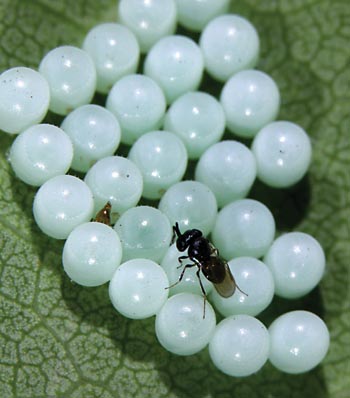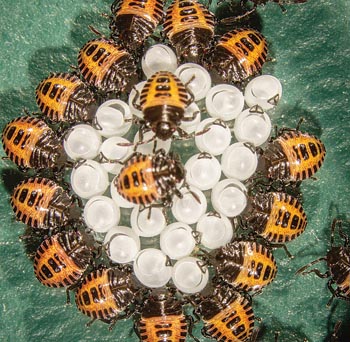The stinkbug injects saliva into the fruit and then sucks out the juice, causing brown areas in the flesh that can resemble bitter pit.
PHOTOS BY NIK WIMAN, OREGON STATE UNIVERSITY
The brown marmorated stinkbug continues to spread, coming alarmingly close to commercial fruit-producing regions of the Pacific Northwest, and new research shows that it flies longer distances than previously suspected.
The pest, which attacks a wide range of plants, was first seen in the United States in 1996 in northeast Pennsylvania, where it presumably arrived with goods imported from Asia. It then spread throughout the Mid-Atlantic region, where it has caused significant damage to apples and other crops, and tormented home owners.
 At the last count, it was in 39 states, including California, Oregon, and Washington, Dr. Peter Shearer, Oregon State University entomologist, reported to growers at winter meetings. Its arrival on the West Coast is particularly worrisome because of the large volume of crops grown and their high value.
At the last count, it was in 39 states, including California, Oregon, and Washington, Dr. Peter Shearer, Oregon State University entomologist, reported to growers at winter meetings. Its arrival on the West Coast is particularly worrisome because of the large volume of crops grown and their high value.
Since the bug (also known as the East Asian stinkbug or the yellow-brown stinkbug) was found in Portland, Oregon, in 2004, it has spread south through Oregon’s Willamette Valley, north into Washington up the Interstate 5 corridor, and east to The Dalles, Mosier, and Hood River, one of Oregon’s prime tree-fruit regions. It is now established in the downtown Hood River area and moving south towards the district’s orchards. One bug was detected in Yakima, Washington.
“If it’s not here yet, it will be sometime,” Shearer warned growers in Wenatchee, Washington.
Hitchhikes
The bug, whose official name is Halyomorpha halys, is bigger than other stinkbugs with a body about the size of a dime. It hitchhikes long distances on campers, vans, and freight trains, which explains how it’s been able to travel from coast to coast. But recent research at OSU has revealed that the bug can get around quite well without any help, thank you very much.
Dr. Nik Wiman, a postdoctoral researcher at OSU in Corvallis, used flight mills to assess how far the bug can fly. The device consists of a lightweight metal rod threaded through a pivot to allow frictionless rotation of the rod. A bug is hot-glued to one end of the rod, and the other end has a counterbalance. As the bug flies, it goes round in circles, and the distance it travels can be calculated from the number of rotations it makes during a certain period.
Wiman found that while most brown marmorated stinkbugs flew ten miles or so in 24 hours, certain males could fly almost 40 miles and some females further than that. Given that a bug can live for weeks and weeks, it has the potential to move long distances, Shearer noted.
“We could be underestimating how important flight is in this pest’s dispersal,” he said. “Once this bug’s in a particular location, it can spread relatively rapidly.”
Stinkbugs belong to a group of insects—along with aphids, pear psylla, and leafhoppers—that have sucking mouthparts. The bugs use their beaks to secrete saliva in the fruit and then suck up the plant juices, discoloring the fruit flesh.
Damage to apples can resemble bitter pit. On peaches, feeding on small fruit causes dimpling, while damage to more mature fruit resembles bruising. The bug has also been seen feeding through peach and maple bark.
Unlike other stinkbug species that move into orchards as the fruit matures and then leave again, the brown marmorated stinkbug can spend its entire lifecycle on fruit crops. In northern regions, it has just one generation per year, but as it extends its range to warmer areas, such as Florida, it could develop through as many as five generations annually, Shearer said.
Hosts
The bug’s host range seems to know no bounds. All tree fruits and small fruits appear susceptible. Shearer said the bug has attacked filberts, piercing the husks and shells to damage the nuts inside. Bugs were seen in commercial vineyards, hazelnut orchards, and caneberry crops in Oregon for the first time this year. Scientists at OSU and the University of Maryland are looking at how bugs might contaminate wine if they get into the crush. The bug has also been seen infesting hop plants, which Shearer said might mean doing similar research on beer contamination.
 It also likes ornamental plants. Wiman has been monitoring the bug’s distribution in the Northwest by visiting different regions and walking the streets checking potential host plants. A smartphone app tracks and maps where he’s walked. English holly is the most common host he’s found, along with maple, lilac, cherry, and the tree of heaven.
It also likes ornamental plants. Wiman has been monitoring the bug’s distribution in the Northwest by visiting different regions and walking the streets checking potential host plants. A smartphone app tracks and maps where he’s walked. English holly is the most common host he’s found, along with maple, lilac, cherry, and the tree of heaven.
Shearer said English holly was imported into Oregon as an ornamental and cultivated for cuttings for the holiday season. Many of the holly farms have closed and been replaced by housing or vineyards, but the plant’s seeds are spread to other locations by birds, and it is now regarded as an invasive species.
Monitoring
A team of more than 50 investigators from 11 institutions across the country is working on a project to find ways to manage the pest. The project, led by Dr. Tracy Leskey at the U.S. Department of Agriculture in Kearneysville, Virginia, has funding from the federal Specialty Crop Research Initiative.
USDA scientists have been developing monitoring tools that could alert growers when bugs arrive in orchards. They have identified an aggregation pheromone from the stinkbug, known as “odor #10” that appears to be effective as a trap lure. They’re also exploring the possibility of using white, black, or blue light to attract bugs to traps.
So, what does a grower do if the bug shows up?
Shearer said it’s difficult to kill with chemicals, and the chemicals that do kill it are the broad-spectrum products that kill everything else—pests and beneficials alike.
“It has put a damper on IPM
Researchers believe biocontrol will be the safest, most effective, and economical approach to tackling the bug and are assessing natural predation and parasitism of the stinkbugs.
Wiman found a native parasitic wasp, Trissolcus cosmopeplae, that lays its eggs in brown marmorated stinkbug eggs. When the young wasps hatch inside the stinkbug eggs they consume and destroy them. Researchers hope that over time, native stinkbug egg parasitoids will increasingly turn their attention to the new invader. Stinkbug predators include crabronidae wasps that grab and paralyze the stinkbugs and haul them back to their nests in the ground to feed them to their young larvae.
Scientists are also looking for natural enemies of the bug where it originated in China, working on the theory that if the bug is not considered a threat there, it might be held in check by biological control. A parasitic wasp called Trissolcus halyomorphae was imported from Beijing and is in quarantine at OSU where scientists are conducting tests to make sure there would not be unforeseen problems should it be released into the environment.
“We’re hoping biological control will help control it,” Shearer said. “If not, this pest will set back our IPM programs at least 50 years.”

Leave A Comment